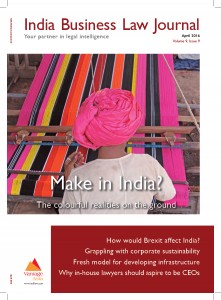“Nobody gave us a chance but every game somebody stepped up and took responsibility”
Words spoken in victory by Darren Sammy, captain of the West Indies cricket team, at the recently concluded World T20 tournament in Kolkata. Sammy’s emotional speech on what was a historic day for West Indies cricket suggests that while there is a lot to be said about the virtues of talking up a project, in the end success is all down to people stepping up to a task and taking responsibility.
The Make in India initiative appears to be an idea whose time has come, especially when persuasive speakers such as Prime Minister Narendra Modi make a case for it. But while there is evidence that it is beginning to change the status quo, can it be said that people involved are stepping up and taking responsibility?
Looking at the realities of investing and making in India, this month’s Cover story takes stock of what has changed since the campaign and its catchy logo of a silhouette of a lion were unveiled. According to an Indian lawyer at a Tokyo law firm, the Make in India campaign “is successful if you view it from how many people are aware of it”. As for whether the campaign is changing investor sentiment about India, international lawyers such as Sherina Petit at Norton Rose Fulbright say there is a visible uptick in interest in India.

One jurisdiction where large-scale change may be looming is the UK, which is to hold a referendum on 23 June to decide whether to leave or remain within the European Union. In Brooding over Brexit we consider what an exit from Europe would mean for Indian investments in the UK and for those companies that have used the UK to access other European markets. As Abhijit Mukhopadhyay, president of legal and European general counsel for the Hinduja Group in London, says, the reality is that many Indian companies consider the EU and the UK as one unit. As such the prospect of the UK exiting the EU and has left them confused about their existing and future investment plans. The uncertainty will no doubt take a toll. Kamal Shah, head of the India and Africa practices at Stephenson Harwood, says because renegotiations of various agreements could take several years, UK-based businesses may be forced to devise strategies and operations contingent on the developments of the UK’s exit process from the EU. “The sheer size of an exit process, which will touch on every single social and economic aspect – tax, companies, people, goods, services, regulations – means that it is almost impossible to state with certainty what measures can be taken to overcome the risks associated with an EU pull-out.”
This month’s What’s the deal? uses a hypothetical case study to illustrate the possibilities for projects in the highway sector that use a new model for public-private partnerships. Building India’s highways has proved to be a complex challenge and with the hybrid annuity model the government has tried to kick-start interest in the sector. The model tweaks the allocation of risk between parties and, equally importantly, the government will be taking on a larger proportion of the costs. Will this work? Developers and investors are bullish about the prospects and our coverage analyses the pros and the cons.
Writing in Vantage point, Kapil Chaudhary, corporate counsel for India and the South Asian region at Autodesk India, suggests there is a compelling case for in-house lawyers to move into business functions within companies. There is ample precedent for this and Chaudhary points out that as businesses get more regulated and complex, legal minds within companies have opportunities to learn the business, engage deeply and strengthen relationships with business clients. This should inspire young in-house lawyers to step outside their comfort zones and learn more about their businesses.
Continuing on the subject of in-house lawyers making their mark within companies, this month’s Intelligence report takes an in-depth look at corporate sustainability. The report details how the need to combine value creation and corporate responsibility can be used by general counsel to enhance value for stakeholders. General counsel have new and diverse roles to play and should devote time to coaching and training so that their colleagues understand and implement the requirements of corporate sustainability to positively protect, propel and enhance their businesses and stakeholder satisfaction.
In order to do this in-house lawyers will need to do just what the West Indies cricketers did at the World T20 tournament: Step up and take responsibility. Don’t wait to be given a chance.



























